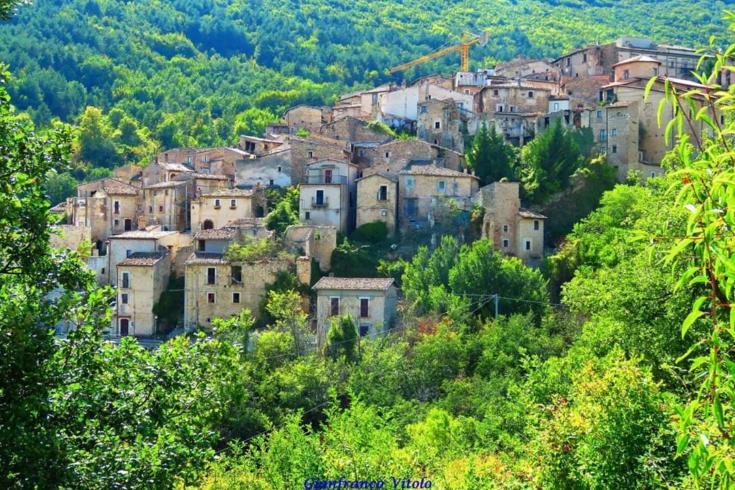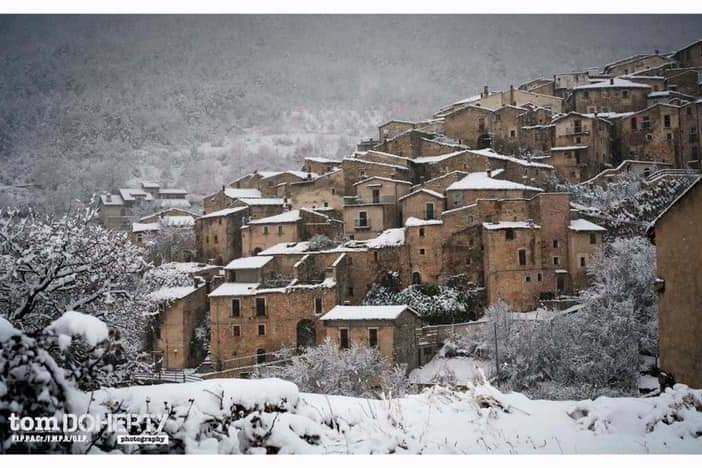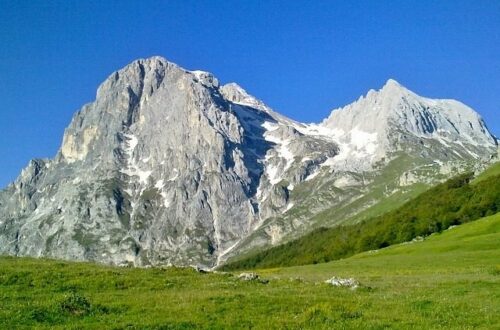
Carapelle Calvisio

By Nancy DeSanti
Province of L’Aquila, Region of Abruzzo
The beautiful small town of Carapelle Calvisio is located in the natural park known as the Gran Sasso e Monti della Laga National Park. It has approximately 120 inhabitants, known as Carapellesi.
It is probably best known as the smallest community in Abruzzo and as being one of the smallest non-alpine comunes in Italy. Its territory was featured, along with Rocca Calascio, in a medieval fantastic movie, “Ladyhawke,” starring Michelle Pfeiffer.
It comprises a handful of stone houses perched at about 900 meters above sea level, among the wooded hills covered with oaks and pines, with a magnificent panoramic view of the Aquila basin up to the Maiella massif and the Navelli plain.
The village stands on one of the last southern reaches of the Gran Sasso massif and the historic center preserves, almost intact, its ancient urban structure of a medieval fortified village, with the houses leaning against each other and separated by narrow alleys that occasionally open into small spaces.

Credit: Gianfranco Vitolo
The area around Carapelle Calvisio has been inhabited since prehistoric times, as evidenced by the many finds dating back to the Paleolithic era. Initially occupied by the people of the Vestini, the area was then conquered by the Romans around the 4th century B.C., after the defeat of the Samnites. With the fall of the Roman Empire, the population moved to the hills and found shelter inside a fort and monasteries.
Despite or maybe because of its small size, the history of Carapelle Calvisio has been troubled. Starting from the 12th century, Carapelle was referred to as a Castrum, that is, as a fortified village. In 1273, Charles I of Anjou conquered this part of Italy, definitively defeating the Swabians. The Angevins put Carapelle Calvisio among the territories of a new barony. At the end of the 1300s, the Angevin ruler Charles III of Durres granted the barony in fiefdom to Peter, Count of Celano.
In following years, the castle was reinforced and nowadays traces of the ancient fortress can be found in the highest part of the town.
Later the Spanish kings of Aragon arrived and the barony was assigned first into the hands of Antonio Piccolomini and then Ottavio Cattaneo. During the Renaissance period, the Church of Saint Francis was established and embellished with frescoes.
In 1579, the territory was under the dominion of the Medici, Grand Dukes of Tuscany, who created the Medici State of Abruzzo to ensure the supply of the fine Carfagna wool, produced by local sheep. This is a fine dark-colored wool with which they made the military uniforms and robes of the monks.
With the Medici and the wool trade, the town went through a period of relative prosperity. Churches were embellished and Palazzo Piccioli was placed in the center of the town.
Like many Abruzzo territories, Carapelle Calvisio also saw many of its inhabitants emigrate in search of fortune after the unification of Italy and after the World Wars. And unfortunately, the village was seriously damaged by the 2009 L’Aquila earthquake.
The most valuable agricultural products in the area are cheeses, sheep meat, olive oil, saffron and especially truffles, which in ancient times were discovered with the use of trained pigs.

Credit: Tom Doherty Photography
One of the characteristic dishes is fried figs, used to season savory dishes such as pasta and eggs, while among the desserts there is the ferratelle (waffle cookies), prepared for the feast of the patron saint, San Pancrazio.
Visitors to the area describe it as a magical place to visit, steeped in the past, and as a starting point to discover the Gran Sasso National Park, which has been described as one of the most beautiful parks in Italy.
After a first wave of emigration started towards the United States, at the time of World War I, a second large emigration followed in the 1950s. Canada, France and Australia were the main destinations. Nowadays in Toronto, there is a Carapellese community five times the present population of the village.
What to See
- The historical center
- The church of St. Francis of Assisi, decorated in the baroque style with beautiful frescoes
- The Shrine of St. Pancrazio.
Important Dates
- May 12 – Feast of St. Pancrazio, the patron saint
- August 15 – Feast of Emigrants
Italiano

Tradotto da Ennio Di Tullio
Provincia di L’Aquila, Regione Abruzzo
Il bellissimo paesino di Carapelle Calvisio si trova nel parco naturale noto come Parco Nazionale del Gran Sasso e Monti della Laga. Conta circa 120 abitanti, detti Carapellesi.
Probabilmente è meglio conosciuta come la più piccola comunità in Abruzzo e come uno dei più piccoli comuni non alpini d’Italia. Il suo territorio è stato protagonista, insieme a Rocca Calascio, in un fantastico film medievale, “Ladyhawke”, con Michelle Pfeiffer.
Si compone di una manciata di case in pietra arroccate a circa 900 metri sul livello del mare, tra le colline boscose ricoperte di querce e pini, con una magnifica vista panoramica sulla conca dell’Aquila fino al massiccio della Maiella e alla piana di Navelli.
Il paese sorge su uno degli ultimi lembi meridionali del massiccio del Gran Sasso e il centro storico conserva, pressoché intatta, l’antica struttura urbanistica di borgo fortificato medioevale, con le case addossate l’una all’altra e separate da stretti vicoli che di tanto in tanto si aprono in piccoli spazi.
Il territorio intorno a Carapelle Calvisio è stato abitato fin dalla preistoria, come testimoniano i numerosi reperti risalenti al Paleolitico. Inizialmente occupata dal popolo dei Vestini, la zona fu poi conquistata dai Romani intorno al IV secolo a.C., dopo la sconfitta dei Sanniti. Con la caduta dell’Impero Romano, la popolazione si trasferì in collina e trovò rifugio all’interno di un forte e di monasteri.
Nonostante o forse proprio per le sue ridotte dimensioni, la storia di Carapelle Calvisio è stata travagliata. A partire dal XII secolo Carapelle fu indicata come Castrum, cioè come borgo fortificato. Nel 1273 Carlo I d’Angiò conquistò questa parte d’Italia, sconfiggendo definitivamente gli Svevi. Gli Angioini collocarono Carapelle Calvisio tra i territori di una nuova baronia. Alla fine del 1300 il sovrano angioino Carlo III di Durazzo concesse la baronia in feudo a Pietro, conte di Celano.
Negli anni successivi il castello fu rinforzato e oggi tracce dell’antica rocca si trovano nella parte più alta del paese.
Successivamente arrivarono i re spagnoli d’Aragona e la baronia fu assegnata prima ad Antonio Piccolomini e poi a Ottavio Cattaneo. In epoca rinascimentale fu eretta la Chiesa di San Francesco, abbellita con affreschi.
Nel 1579 il territorio passò sotto il dominio dei Medici, Granduchi di Toscana, che crearono lo Stato Medici d’Abruzzo per garantire l’approvvigionamento della pregiata lana Carfagna, prodotta dalle pecore locali. Si tratta di una pregiata lana di colore scuro con cui si confezionavano le divise militari e le vesti dei monaci.
Con i Medici e il commercio della lana, il paese visse un periodo di relativa prosperità. Furono abbellite le chiese e al centro del paese fu collocato Palazzo Piccioli.
Come molti territori abruzzesi, anche Carapelle Calvisio ha visto molti dei suoi abitanti emigrare in cerca di fortuna dopo l’Unità d’Italia e dopo le Guerre Mondiali. E purtroppo il paese è stato gravemente danneggiato dal terremoto dell’Aquila del 2009.
I prodotti agricoli più pregiati della zona sono i formaggi, la carne di pecora, l’olio d’oliva, lo zafferano e soprattutto i tartufi, che anticamente venivano scoperti con l’utilizzo di maiali allevati.
Uno dei piatti caratteristici sono i fichi fritti, usati per condire pietanze salate come pasta e uova, mentre tra i dolci vi sono le ferratelle, preparate per la festa del patrono San Pancrazio.
I visitatori della zona lo descrivono come un luogo magico da visitare, ricco di passato, e come punto di partenza per scoprire il Parco Nazionale del Gran Sasso, che è stato definito uno dei parchi più belli d’Italia.
Dopo che iniziò una prima ondata di emigrazione verso gli Stati Uniti, all’epoca della prima guerra mondiale, seguì negli anni ’50 una seconda grande emigrazione. Canada, Francia e Australia sono state le destinazioni principali. Oggi a Toronto c’è una comunità carapellese cinque volte la popolazione attuale del villaggio.
Attrazioni del luogo:
- Il centro storico
- La chiesa di San Francesco d’Assisi, decorata in stile barocco con bellissimi affreschi
- Il Santuario di San Pancrazio
Date da ricordare:
- 12 maggio – Festa di San Pancrazio, patrono
- 15 agosto – Festa degli Emigranti
| Sources: |
| https://en.wikipedia.org/wiki/Carapelle_Calvisio https://www.italyheritage.com/regions/abruzzo/laquila/carapelle.htm https://discoverplaces.travel/en/Places2/guide-to-carapelle-calvisio/ |
May/June 2022





